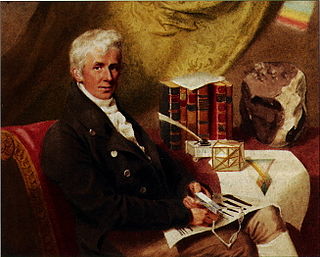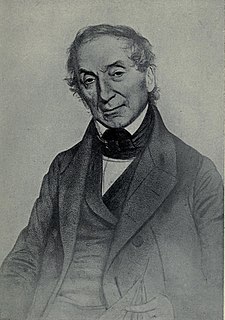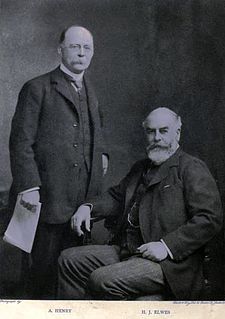
Sir Joseph Banks, 1st Baronet, was an English naturalist, botanist, and patron of the natural sciences.

The Royal Horticultural Society (RHS), founded in 1804 as the Horticultural Society of London, is the UK's leading gardening charity.

Allan Cunningham was an English botanist and explorer, primarily known for his travels in Australia to collect plants.

Sir Joseph Dalton Hooker was a British botanist and explorer in the 19th century. He was a founder of geographical botany and Charles Darwin's closest friend. For twenty years he served as director of the Royal Botanical Gardens, Kew, succeeding his father, William Jackson Hooker, and was awarded the highest honours of British science.

Sir William Jackson Hooker was an English botanist and botanical illustrator, who became the first director of Kew when in 1841 it was recommended to be placed under state ownership as a botanic garden. At Kew he founded the Herbarium and enlarged the gardens and arboretum. The standard author abbreviation Hook. is used to indicate this person as the author when citing a botanical name.

James Sowerby was an English naturalist, illustrator and mineralogist. Contributions to published works, such as A Specimen of the Botany of New Holland or English Botany, include his detailed and appealing plates. The use of vivid colour and accessible texts were intended to reach a widening audience in works of natural history. The standard author abbreviation Sowerby is used to indicate this person as the author when citing a botanical name.

Nathaniel Wolff Wallich FRS FRSE was a surgeon and botanist of Danish origin who worked in India, initially in the Danish settlement near Calcutta and later for the Danish East India Company and the British East India Company. He was involved in the early development of the Calcutta Botanical Garden, describing many new plant species and developing a large herbarium collection which was distributed to collections in Europe. Several of the plants that he collected were named after him.

John Lindley FRS was an English botanist, gardener and orchidologist.
George Caley was an English botanist and explorer, active in Australia for the majority of his career.

Kew Palace is a British royal palace within the grounds of Kew Gardens on the banks of the River Thames. Originally a large complex, few elements of it survive. Dating to 1631 but built atop the undercroft of an earlier building, the main survivor is known as the Dutch House. Its royal occupation lasted from around 1728 until 1818, with a final short-lived occupation in 1844. The Dutch House is Grade I listed, and open to visitors. It is cared for by an independent charity, Historic Royal Palaces, which receives no funding from the government or the Crown. Alongside the Dutch House is a part of its 18th-century service wing, whilst nearby are a former housekeeper's cottage, brewhouse and kitchen block – most of these buildings are private, though the kitchens are open to the public. These kitchens and Queen Charlotte's Cottage are also run by Historic Royal Palaces.
James Backhouse (1825–1890) was an English botanist, archaeologist, and geologist. He was the son of James Backhouse (1794–1869), a botanist and missionary in Australia.
The Victoria Medal of Honour (VMH) is awarded to British horticulturists resident in the United Kingdom whom the Royal Horticultural Society Council considers deserving of special honour by the Society.

Augustine Henry was a British-born Irish plantsman and sinologist. He is best known for sending over 15,000 dry specimens and seeds and 500 plant samples to Kew Gardens in the United Kingdom. By 1930, he was a recognised authority and was honoured with society membership in Belgium, Czechoslovakia, Finland, France, and Poland. In 1929 the Botanical Institute of Peking dedicated to him the second volume of Icones plantarum Sinicarum, a collection of plant drawings. In 1935, John William Besant was to write: 'The wealth of beautiful trees and flowering shrubs which adorn gardens in all temperate parts of the world today is due in a great measure to the pioneer work of the late Professor Henry'.

George Thomson was a Scottish missionary in Cameroon who collected plants to send to the Royal Botanic Gardens, Kew and to the British Museum.

William Lobb was a British plant collector, employed by Veitch Nurseries of Exeter, who was responsible for introducing to commercial growers Britain Araucaria araucana from Chile and the massive Sequoiadendron giganteum (Wellingtonia) from North America.

Lee and Kennedy were two families of prominent Scottish nurserymen in partnership for three generations at the Vineyard Nursery in Hammersmith, west of London. "For many years," wrote John Claudius Loudon in 1854, "this nursery was deservedly considered the first in the world."
James Bowie was an English botanist.
John Graefer or Johann Andreas Graeffer was a German botanist nurseryman born in Helmstedt. Graeffer/Graefer is remembered by garden historians as having introduced a number of exotic plants to British gardens and to have worked for the king of Naples at the palace of Caserta.

Elian Emily Collins was an English botanist, naturalist and an early collector of plant specimens in Thailand. She discovered several plant species new to science and had numerous species named after her.

The Palm House is a large palm house in the Royal Botanic Gardens, Kew, in London, that specialises in growing palms and other tropical and subtropical plants. It was completed in 1848. Many of its plants are endangered or extinct in the wild. Features include an upper walkway, taking the visitor into the branches of the larger plants. Kew also has the even larger "Temperate House", kept at lower temperatures.